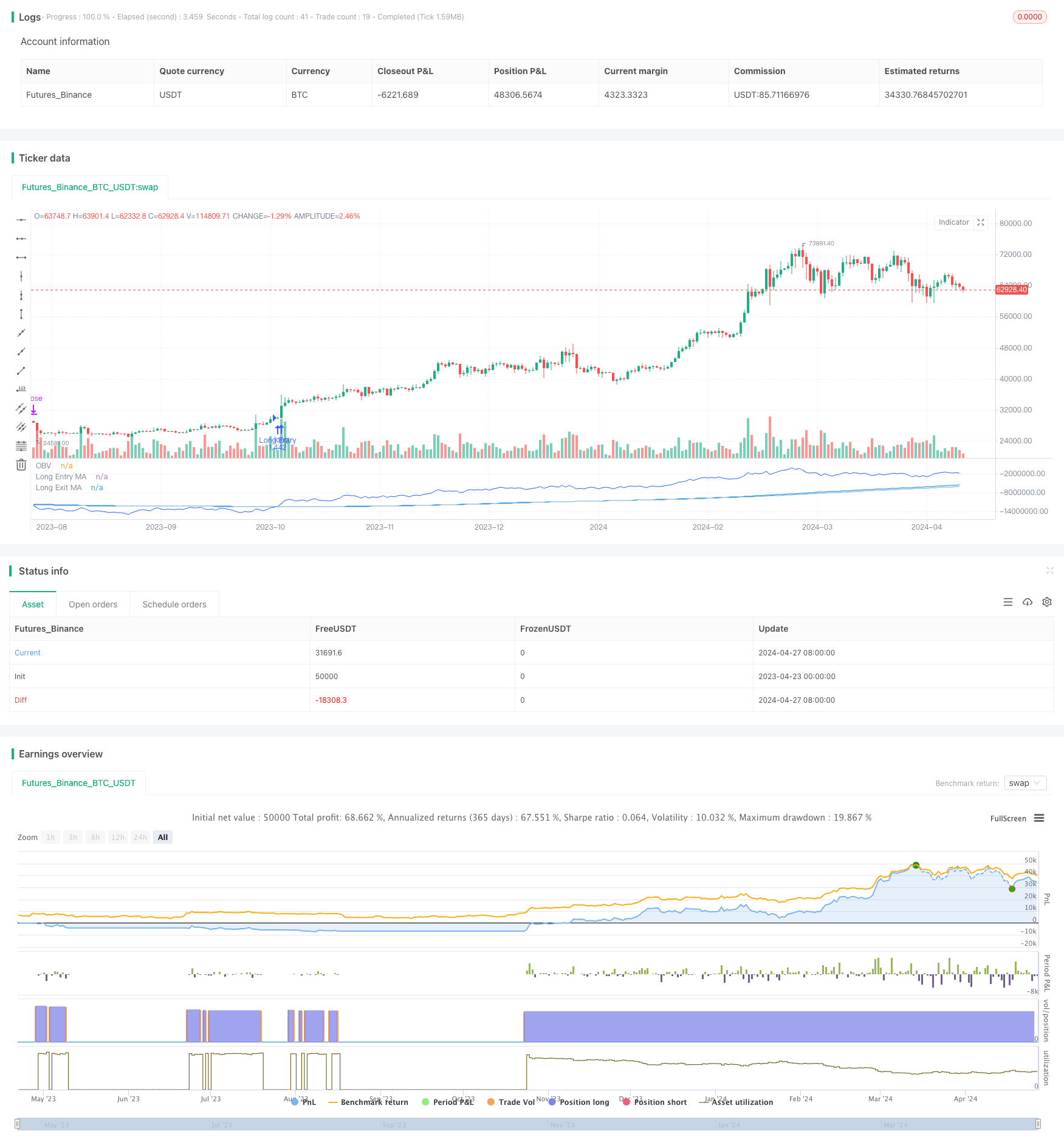
概述
本策略名为”OBVious MA Strategy 基于OBV与MA交叉信号的趋势跟踪策略”,核心是使用OBV(On Balance Volume)指标与移动平均线的交叉来产生交易信号。OBV可以提供领先的趋势信号,本策略利用OBV突破移动平均线作为进场和出场条件,以捕捉趋势。同时使用独立的进场MA和出场MA,可以更灵活地控制持仓时间。该策略虽然是一个简单的演示,但展现了如何有效利用OBV进行量价分析。
策略原理
- 计算OBV指标值:若当前收盘价高于前一根K线,则OBV加上当前成交量,否则减去成交量。
- 计算OBV的四条移动平均线:长周期做多进场MA、长周期做多出场MA、短周期做空进场MA和短周期做空出场MA。
- 产生交易信号:
- 当OBV上穿长周期做多进场MA且方向过滤器不为做空时,开多仓
- 当OBV下穿长周期做多出场MA时,平多仓
- 当OBV下穿短周期做空进场MA且方向过滤器不为做多时,开空仓
- 当OBV上穿短周期做空出场MA时,平空仓
- 交易管理:若有反向信号产生,会先平掉原有仓位再开新仓位。
策略优势
- 充分利用OBV领先的趋势信号,在趋势初期就能及时建仓。
- 将进场和出场MA分离,可以独立优化进出场时机。
- 代码逻辑简单清晰,易于理解和改进。
- 引入方向过滤,可避免频繁交易,降低成本。
策略风险
- 缺乏其他确认指标,可能产生假信号。建议结合其他指标使用。
- 缺乏止损和仓位管理,面临单笔亏损放大的风险。可以加入合理的止损和资金管理措施。
- 参数选择不当会影响策略表现。需要根据不同市场特点和周期进行参数优化。
策略优化方向
- 可以尝试引入趋势过滤,如MA方向、ATR等,以改善信号质量。
- 可以在OBV上使用不同类型的MA,如EMA、WMA等,捕捉不同速度的趋势。
- 可以优化仓位管理,如采用加减仓策略,在趋势强度提升时加仓,降低时减仓。
- 可以结合其他量价指标,如MVA、PVT等,构建联合信号来提高胜率。
总结
本策略展示了一种基于OBV与MA交叉的简单趋势跟踪方法。优点是逻辑清晰,能够及时捕捉趋势,通过分离进出场MA可以灵活控制持仓。但缺点是缺乏风险控制措施以及信号确认手段。后续可以从趋势过滤、参数优化、仓位管理、联合信号等方面进行改进,以期获得更稳健的策略表现。本策略更适合作为一个向导信号,配合其他策略来使用。
策略源码
/*backtest
start: 2023-04-23 00:00:00
end: 2024-04-28 00:00:00
period: 1d
basePeriod: 1h
exchanges: [{"eid":"Futures_Binance","currency":"BTC_USDT"}]
*/
// This Pine Script™ code is subject to the terms of the Mozilla Public License 2.0 at https://mozilla.org/MPL/2.0/
// © ThousandX_Trader
//@version=5
strategy(title="OBVious MA Strategy [1000X]", overlay=false,
initial_capital=10000, margin_long=0.1, margin_short=0.1,
default_qty_type=strategy.percent_of_equity, default_qty_value=100,
slippage=1, commission_type=strategy.commission.percent, commission_value=0.1)
// Direction Input ///
tradeDirection = input.string("long", title="Direction", options=["long", "short"], group = "Direction Filter")
///////////////////////////////////////
// 1000X OBV MA INDICATOR //
///////////////////////////////////////
// OBV Trend Length Inputs //
long_entry_length = input(190, title="Long Entry MA Length", group = "Moving Average Settings")
long_exit_length = input(202, title="Long Exit MA Length", group = "Moving Average Settings")
short_entry_length = input(395, title="Short MA Entry Length", group = "Moving Average Settings")
short_exit_length = input(300, title="Short Exit MA Length", group = "Moving Average Settings")
// OBV Calculation
obv = ta.cum(ta.change(close) >= 0 ? volume : -volume)
// Calculate OBV Moving Averages
obv_ma_long_entry = ta.sma(obv, long_entry_length)
obv_ma_long_exit = ta.sma(obv, long_exit_length)
obv_ma_short_entry = ta.sma(obv, short_entry_length)
obv_ma_short_exit = ta.sma(obv, short_exit_length)
///////////////////////////////////////
// STRATEGY RULES //
///////////////////////////////////////
longCondition = ta.crossover(obv, obv_ma_long_entry) and tradeDirection != "short" and strategy.position_size <= 0
longExitCondition = ta.crossunder(obv, obv_ma_long_exit)
shortCondition = ta.crossunder(obv, obv_ma_short_entry) and tradeDirection != "long" and strategy.position_size >= 0
shortExitCondition = ta.crossover(obv, obv_ma_short_exit)
///////////////////////////////////////
// ORDER EXECUTION //
///////////////////////////////////////
// Close opposite trades before entering new ones
if (longCondition and strategy.position_size < 0)
strategy.close("Short Entry")
if (shortCondition and strategy.position_size > 0)
strategy.close("Long Entry")
// Enter new trades
if (longCondition)
strategy.entry("Long Entry", strategy.long)
if (shortCondition)
strategy.entry("Short Entry", strategy.short)
// Exit conditions
if (longExitCondition)
strategy.close("Long Entry")
if (shortExitCondition)
strategy.close("Short Entry")
///////////////////////////////////////
// PLOTTING //
///////////////////////////////////////
// Plot OBV line with specified color
plot(obv, title="OBV", color=color.new(#2962FF, 0), linewidth=1)
// Conditionally plot Long MAs with specified colors based on Direction Filter
plot(tradeDirection == "long" ? obv_ma_long_entry : na, title="Long Entry MA", color=color.new(color.rgb(2, 130, 228), 0), linewidth=1)
plot(tradeDirection == "long" ? obv_ma_long_exit : na, title="Long Exit MA", color=color.new(color.rgb(106, 168, 209), 0), linewidth=1)
// Conditionally plot Short MAs with specified colors based on Direction Filter
plot(tradeDirection == "short" ? obv_ma_short_entry : na, title="Short Entry MA", color=color.new(color.rgb(163, 2, 227), 0), linewidth=1)
plot(tradeDirection == "short" ? obv_ma_short_exit : na, title="Short Exit MA", color=color.new(color.rgb(192, 119, 205), 0), linewidth=1)
相关推荐